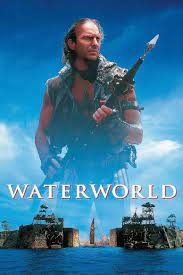
In the year 2500, because sea-levels have risen 8,200 meters, every continent is under water. What remains of the human race lives on floating communities called atolls. Some believe in a place called dryland. The Mariner (Kevin Costner) lives on his trimaran, selling precious dirt for a living. He has gills and webbed feet. When he visits an atoll, the authorities decide to compost him as a mutant, but the atoll is attacked by Smokers, who are searching for a girl named Enola, who they believe has a map to dryland tattooed on her back. Enola (Tina Masorino) and her guardian Helen (Jeanne Tripplehorn) free the Mariner and escape on his ship.
She allows the ship to be damaged and he refuses to take her to dryland. She wants to know where he gets his dirt, and he shows her the bottom of the sea, where he gets it. When they surface, they find the Smokers have caught up with them. They abduct Enola and try to kill the Mariner and Helen, but they escape underwater. The boat is destroyed. A old man named Gregor (Michael Jeter) rescues them in his balloon and takes them to an atoll.
The Mariner takes a Smoker’s jet-ski and chases down the leader of the Smokers, Deacon (Dennis Hopper) aboard the ancient hulk of the Exxon Valdez. The Mariner threatens to set the oil on fire unless he returns Enola. When Deacon resists, the Mariner actually sets the ship on fire. Gregor rescues Enola and they escape on Gregor’s balloon with Helen and the atoll enforcer (R.D. Call). The Deacon tries to grab Enola but ends up just losing more men and probably dead. Gregor is able to find Dryland—a seashore near Mount Everest. They find the bodies of Enola’s parents. She is home. The Mariner builds another ship and sails away.
The film was directed by Kevin Reynolds and written by Peter Rader and David Twohy, based on Rader’s original screenplay. It was produced by Charles Gordon, John Davis, and Kevin Costner. It was the most expensive film ever made at the time, until Titanic. It met mixed reviews and was not a money-maker until the DVD came out. There was a novelization, a video game, and four themed attractions in Hollywood, Singapore, Japan, and Beijing. The film was inspired by Mad Max, the Old Testament, and the story of Helen of Troy. Despite warnings from Steven Spielberg, it was filmed in the Pacific Ocean off Hawaii, and the expensive set was destroyed by a hurricane. Joss Whedon was called in to fix the script for “Seven weeks of Hell.” It was nominated for one Oscar, two Saturns, four Golden Raspberries, and two Stinkers.
Melting icecaps could obviously not raise sea-levels to Mount Everest. The most I’ve heard is 100 feet. The racing yacht (two of them, in fact) was 60 feet long. The floating atoll used up all the steel in Hawaii and more had to be flown in from California. The runway at Kona Airport had to be extended to accommodate the plane. Costner put 22 million dollars of his own money in the film. However, the economy of the State of Hawaii made 35 million from it. Filming out in the ocean required thirty boats for cast and crew, cameras, lights, makeup, etc. But there were no toilets, so people had to be ferried to shore several times a day. They also spent money in post-production fixing Costner’s receding hairline.
Everybody ate Ginger Snaps to ward off seasickness. Costner nearly died when a squall came up when he was tied to the mast. His stunt double nearly died too. Jeanne Tripplehorn would not do nude scenes, so she had three body doubles. One trimaran sank and the female leads nearly drowned. The other boat was sold to Turkish businessman Hakan Uzan. His family went bankrupt, and the government auctioned off the boat. Despite all this nonsense, they came up with an enjoyable movie. Costner is a little wooden, and Dennis Hopper quite over the top, but there are some lyrical moments and it does take you somewhere you’ve never been before, which is what I go to science-fiction for in the first place.
